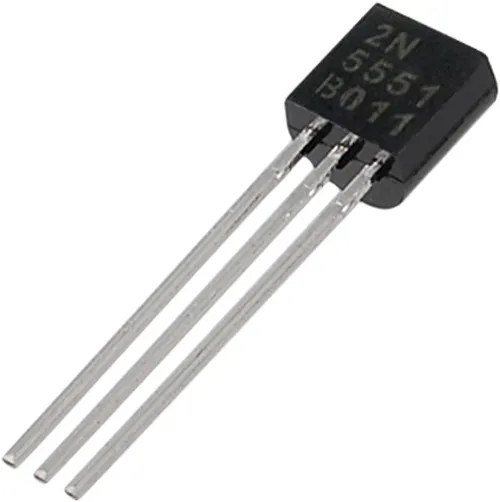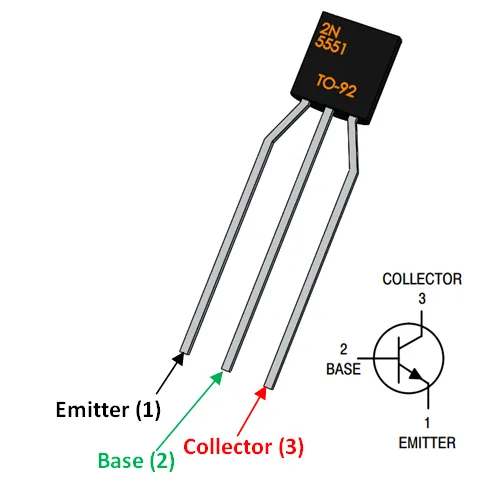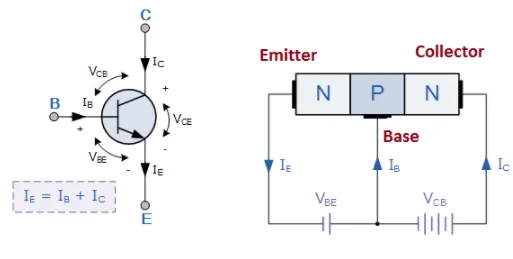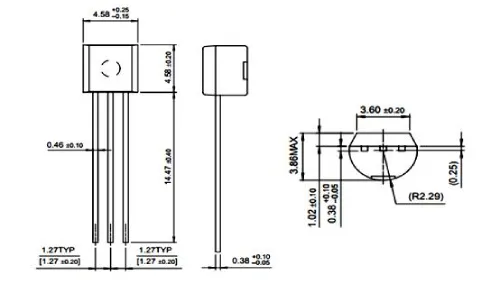2N5551 Transistor:Features,Applications and Pinout
The 2N5551 transistor is a type of semiconductor device utilized for switching or amplifying electronic signals and electrical power. It features at least three terminals that connect to external circuits. When current or voltage is applied to one terminal pair, it regulates the current flow in the other terminal pair. Typically, a transistor amplifies a signal when the output power exceeds the input power. This article provides an overview of the 2N5551 transistor, including its pinout, specifications, circuit operation, and applications.
What is a 2N5551 Transistor?
The 2N5551 NPN amplifier transistor is primarily designed for high voltage circuits used for general purposes such as switching and amplification. The voltage from the collector terminal to the emitter is 160V, and the voltage from the collector terminal to the base is 180V, allowing it to be easily used in circuits operating below 160 volts. This transistor can handle a maximum output load of 600mA, and the maximum dissipation of the collector terminal is 625mW.

2N5551 Transistor Pin Configuration
The pin configuration of the 2N5551 Transistor is shown below. This transistor includes three terminals which are discussed below.

- - Pin1 (Emitter): This terminal is generally connected to the GND terminal where the flow of current drains out through this terminal.
- - Pin2 (Base): This pin controls the transistor biasing, so this pin controls the transistor.
- - Pin3 (Collector): This terminal is connected to the load, and current supplies flow through this terminal.
Compared to JFET, it is very different, so it is known as a voltage-controlled device. Once the voltage is applied at the base terminal of this transistor, it will be activated, allowing the current to flow through it. Here, the flow of current works like a bridge between the collector and emitter terminals.
Features & Specifications
The features and specifications of the 2N5551 transistor are as follows:
- - Utilizes advanced process technology
- - Low error voltage
- - Very fast switching speed
- - Wide voltage operating range
- - High power and current handling capacity
- - NPN amplifier transistor
- - High DC gain, reaching up to 80 when \( I_C = 10 \) mA
- - Continuous collector current (\( I_C \)) of 600 mA
- - Collector-to-emitter voltage (\( V_{CE} \)) is 160 V
- - Collector-to-base voltage (\( V_{CB} \)) is 180 V
- - Emitter-to-base voltage (\( V_{BE} \)) is 6 V
- - Packaged in To-92 Package
- - Transition frequency of 100 MHz
- - Maximum collector current (\( I_{C(\text{max})} \)) is 6A/600mA
- - Maximum collector terminal dissipation (\( P_{\text{diss}} \)) is 625 mW
- - DC gain range is from 80 to 250
- - Operating and storage temperature range is from -55°C to +150°C
Complementary to the 2N5551 transistor is the 2N5401, and equivalent transistors include 2N5551K, BC637, NTE194, BC639, 2N5833, BC487, and 2N5551G. A similar transistor to the 2N5551 is the 2N5550.
How to Safely Operate a 2N5551 Transistor?
To ensure optimal performance and longevity of the 2N5551 transistor in electronic circuits, follow these guidelines:
- Avoid exceeding the voltage rating of 160V to prevent damage.
- Maintain a voltage supply between 5V and 10V below the maximum ratings for safety.
- Use an appropriate base resistor to provide the required base current and avoid exceeding the maximum collector current of 600mA.
- Ensure the operating temperature remains within the range of > -55°C and < +150°C.
How to Use a 2N5551 Transistor?
When biasing the 2N5551 transistor, the current in the emitter terminal equals the sum of the currents in the base and collector terminals. Apply a positive voltage at the base terminal relative to the current flow from the emitter (E) to the collector (C).
The transistor's characteristics are primarily determined by the forward current gain, known as Beta (β), which is the ratio of collector current to base current. This amplification factor (β) determines the amplified current value.
The β value typically ranges from 20 to 1000, with a typical value around 200. Another essential factor is the transistor's current gain, denoted by α (alpha), which is the ratio of collector current to emitter current. This value generally ranges from 0.95 to 0.99, but it is often used as unity.
Circuit Diagram with 2N5551 NPN Transistor
The 2N5551 transistor is commonly used for amplification. Below is a simple example circuit demonstrating an amplified sine wave output.
In this circuit, the input sine wave magnitude is amplified from 8mV to 50mV. Resistors R3 and R4 form a potential divider to determine the emitter-base voltage (VBE). R1 serves as the load resistor, while R2 acts as the emitter resistor. The amplification of the output signal can be adjusted by changing the value of RL.

In a transistor, the current flowing through the base terminal can be amplified in the current flowing through the collector terminal. This amplification primarily relies on the hfe (amplification factor), with a value of 80 indicating that the collector current (CC) will change by eighty times compared to the base current.
I_c = \beta \times I_b
The emitter current of this transistor, denoted as 'IE', is nearly equivalent to the collector current due to transistor action. The main distinction between these two can be identified through the 'α' value. Typically, the collector current value can be expressed as:
IE = IC + IB
The output beyond the collector terminal, known as VCE (Collector-Emitter), is obtained. The output voltage depends mainly on Vin = 12V without any voltage drop across R1. Therefore, the output voltage, Vout, can be expressed as:
Vout = VCE = (Vcc - Ic \times Rc)
2N5551 Transistor Package Dimensions
The 2D model and dimensions from the 2N5551 datasheet are provided below, offering insight into the package type and dimensions.

Where to Use the 2N5551 Transistor? / Applications
The 2N5551 transistor finds applications in the following areas:
Circuits operating at high voltages for general-purpose applications.
Audio amplification, enhancing audio signals and other electronic signals. Additionally, it can be used in applications where general-purpose transistors like 2N3904/BC547 are employed, such as driving LEDs, ICs, and controlling electronic circuits.
- Darlington pair configurations.
- Amplifying low-power signals.
- Driver stages for audio frequencies.
- Low-power audio amplifiers.
- For loads below 600mA.
- Amplifiers including low-power, current amplifiers, audio or other signal boosters.
- Due to its high breakdown voltage, it is suitable for use in display drivers with gas discharge.
- The amplification feature of this transistor makes it suitable for various professional applications.
This overview covers the 2N5551 transistor datasheet, including its pin configuration, specifications, features, circuits, and applications. This NPN transistor serves for both switching and amplification purposes. It is designed for low power, medium voltage, and can operate efficiently at high speeds. As a question for you, what are the different types of amplifier transistors available in the market?
FAQ
How to Ensure Safe and Long-Term Operation of a 2N5551 Transistor in a Circuit?
When used correctly, electronic components can exhibit high reliability and longevity. It's essential to adhere to maximum ratings to avoid component failure. Operating components at least 20% below their maximum ratings ensures prolonged performance. The 2N5551 transistor should be utilized following these guidelines. Its maximum drain-source voltage is 30V, with the drain-gate voltage not exceeding 24V and the gate-source voltage staying below -24V. It's advisable to limit the drain current to 25mA and avoid loading it with more than 20mA. Additionally, ensure the transistor is neither stored nor operated below -55°C or above +150°C.
Everything You Need to Know About the 2N5551 Transistor in Electronics
How does an NPN transistor function as an amplifier?
An NPN transistor acts as an amplifier by increasing the power of weak signals. The DC bias voltage applied to the base-emitter junction keeps it in a forward-biased state, regardless of the signal polarity.
What is the role of an NPN transistor?
An NPN transistor comprises a P-type material sandwiched between two N-type materials. It amplifies weak signals entering the base, producing amplified signals at the collector.
How does an NPN transistor differ from a PNP transistor?
The main distinction between an NPN and a PNP transistor lies in their activation mechanisms. An NPN transistor activates when current flows through the base, with current flowing from the collector to the emitter. Conversely, a PNP transistor is activated in the absence of base current flow.
2N5551 vs 2N2222
What is 2N5551?
The 2N5551 is an NPN amplifier transistor characterized by an amplification factor (hfe) of 80 when the collector current is 10mA. It exhibits good signal-shifting properties, enabling it to amplify low-level signals effectively.
What is the use of 2N2222 transistor?
The 2N2222 transistor is designed for general-purpose low-power amplification and switching tasks. It is specifically tailored for low-to-medium current, low power, and medium voltage applications, capable of operating at moderately high speeds.
BC547 vs 2N2222
Can I use 2N2222 instead of BC547?
Yes, either a 2N2222 or a BC547 NPN transistor can be used interchangeably in a circuit. Circuit modifications are feasible; however, it's essential to verify Ic and Vceo parameters from the datasheet.
What is the difference between BC547 and BC548?
Although BC547 and BC548 NPN transistors share many characteristics, they differ in voltage ratings. BC546 and BC547 are essentially the same as BC548 but have higher breakdown voltages. BC549 is a low-noise variant, while BC550 is a high-voltage and low-noise variant.
BC547 vs BC548
What is BC548 transistor?
The BC548 is a versatile NPN bipolar junction transistor extensively used in electronic devices. It often serves as the first bipolar transistor encountered by enthusiasts.
Can we use BC548 instead of BC547?
No, BC547 is an NPN transistor, whereas BC548 is a PNP transistor. They are not interchangeable, as they have different polarities.
Related Articles
BC338 NPN Transistor: Features, Applications, and FAQ
2N4401 NPN Transistor: Datasheet, Applications, and Features
BC338 NPN Transistor: Features, Applications, and FAQ
What is the BC547 Transistor? Its Features & Applications
Phototransistor : Circuit Pinout & Principle
What is Thin-Film Transistor(tft) monitors? All explained
Transistor Series Voltage Regulator:All You Need to Know
Junction Field-Effect Transistors: Principles, Applications, and Advantages
Insulated Gate Bipolar Transistor:Features and Pinout
PNP Transistor? Construction, Working & Applications
2N3904S Transistor: Features, Applications, and Datasheet
BSN254A Transistor: Applications, Datasheet, and Equivalent
13009D Transistor: Applications, Equivalent and Specifications










